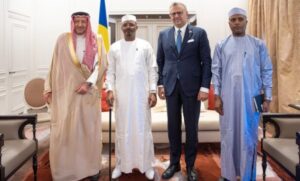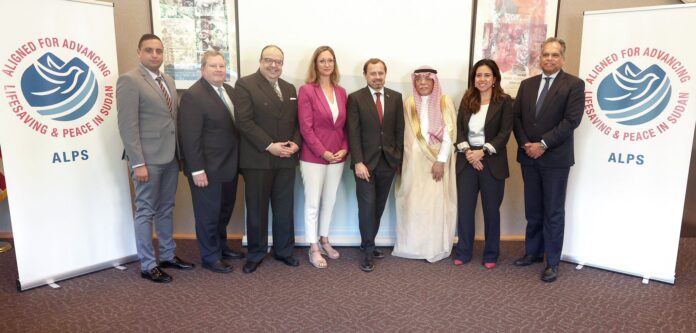The Quadrilateral Mechanism Between Washington and N’Djamena: Re-engineering Regional Mediation in Sudan
By Zaelnoon Suliman – African Affairs Unit, Progress Center for Policies
Introduction:
In recent weeks, the regional landscape has witnessed intense diplomatic activity led by the United States and its Arab partners, as part of renewed efforts to end the conflict in Sudan and restore regional stability.
This renewed push falls within ongoing efforts to revitalize the “Quadrilateral Mechanism” — comprising the United States, Saudi Arabia, the United Arab Emirates, and the United Kingdom — and to resurrect the political settlement process, after more than two years of war that have severely weakened Sudan’s state institutions.
Details
On October 16, 2025, a formal meeting was held in Rome, bringing together Chadian President Mahamat Idriss Déby Itno, Saudi Deputy Foreign Minister Waleed Al-Khuraiji, and U.S. Presidential Adviser for African Affairs Mossad Bolous.
The discussions focused on coordinating efforts to enhance security and stability in Sudan and to address related regional conflicts.
Bolous stated on Platform X that Washington, through the Quadrilateral Mechanism, is taking “urgent and coordinated measures” to restore peace and end the suffering of the Sudanese people. He also noted a shared understanding with Saudi Arabia regarding a common approach to addressing the crisis.
The Saudi Ministry of Foreign Affairs confirmed in a statement that the meeting discussed “intensifying efforts to promote security and peace in the region, particularly in Sudan.”
On October 15, Bolous met with Egyptian President Abdel Fattah El-Sisi in Cairo, where both sides stressed the need to halt military escalation and support a comprehensive political process to end the war and restore state institutions.
Simultaneously, Sudan’s Sovereign Council Chairman Abdel Fattah Al-Burhan held talks with President El-Sisi on the regional role of the Quadrilateral Mechanism and its importance as a unifying framework to end the war and re-establish stability.
Earlier, in September 2025, the Quadrilateral Mechanism had approved a roadmap that included an initial three-month humanitarian truce, paving the way for negotiations toward a permanent ceasefire and a transition phase under UN supervision.
Analysis
These recent developments mark an attempt to reactivate international efforts after a prolonged stalemate.
In March, the Sudanese government had provisionally agreed to resume negotiations based on a roadmap calling for the withdrawal of Rapid Support Forces (RSF) from major cities and their regrouping in camps within Darfur — as a preliminary step toward defining their future political and military status.
For its part, the RSF has demanded a political role in the upcoming transitional phase, representing one of the key points of divergence between the two sides.
The successive meetings in Cairo and Rome indicate that Washington seeks to reactivate the Quadrilateral Mechanism as a central platform for Arab–international coordination, leveraging the Saudi–Emirati role in managing field communications and the Egyptian–Chadian role in mediating with armed actors inside Sudan.
The overarching objective is to prevent the disintegration of the Sudanese state and establish a balance conducive to a comprehensive ceasefire, alongside the creation of UN-supervised humanitarian corridors.
Chad’s Regional Role: The New Field Mediator
Chad’s entry into the Sudanese crisis represents a qualitative shift in the architecture of regional mediation. N’Djamena has transitioned from a border observer to a direct actor in managing the de-escalation process between the Sudanese army and the RSF.
This shift has taken place with clear U.S.–Saudi backing, as demonstrated in the Rome meeting, where Chad was formally recognized as a field partner in implementing the Quadrilateral roadmap.
Washington and Riyadh are leveraging Chad’s role as an informal communication channel with RSF leadership and as a means of limiting Russian influence in Darfur — by tightening border control and constraining non-state actors.
For N’Djamena, engagement in the Sudanese file offers an opportunity to enhance its regional standing, secure its eastern borders against arms proliferation, and provide President Mahamat Idriss Déby with additional political capital as an African mediator accepted by both Arab and international partners.
In this context, Chad has emerged as the “new field mediator” in the Sudanese equation, capitalizing on its geographic proximity, tribal linkages in Darfur, and U.S.–Saudi support to consolidate its position within the evolving architecture of regional peace efforts.

Limits and Risks of Chad’s Role
Despite its importance in creating a conducive environment for negotiations, Chad’s expanding role could generate regional sensitivities and new tensions within the Sudanese equation.
From the Sudanese army’s perspective, N’Djamena’s involvement is viewed with caution, given its tribal and military ties to certain RSF leaders. This raises concerns that the mediation might become a channel of pressure on Port Sudan, rather than a neutral balancing force.
Egypt, traditionally the main supporter of Sudan’s military establishment, may see the enlargement of Chad’s role as coming at the expense of its natural influence over the Sudan file — especially if this expansion occurs under U.S.–Saudi sponsorship outside Cairo’s coordination.
Domestically, there is a risk that President Déby could politicize his involvement in Sudan to bolster his internal legitimacy, potentially exposing the mediation to instability within Chad itself.
Therefore, Chad’s success will depend on its ability to maintain genuine neutrality, ensure ongoing coordination with Cairo and Port Sudan, and operate strictly within the Quadrilateral framework rather than outside it. Any excessive field involvement risks reigniting historical border and political disputes between Sudan and Chad instead of helping to resolve them.
Conclusion
The current U.S.-led efforts aim to create a new negotiation environment between the Sudanese Armed Forces (SAF) and the Rapid Support Forces (RSF) by reactivating the Quadrilateral Mechanism and aligning positions with regional partners.
The Rome meeting underscored Chad’s re-emergence as a key field player, leveraging its geographic, tribal, and military connections to Darfur to facilitate contact with the RSF.
U.S. and Saudi statements point to a preliminary consensus on a common path that begins with de-escalation and moves toward a gradual political process.
The upcoming Washington meeting is expected to serve as a new starting point for the settlement process, particularly since Khartoum has already declared its readiness to return to negotiations.
If the roadmap is implemented, a limited transitional phase may begin under UN supervision and the sponsorship of an expanded Quadrilateral Mechanism (including Egypt and Chad).
Should the Washington meeting fail, a temporary humanitarian truce will likely be proposed, alongside continued diplomatic pressure for another round of talks — either in Jeddah or Washington.
Overall Assessment
Current indicators suggest that the revival of the Quadrilateral Mechanism represents the last serious opportunity to prevent Sudan’s complete fragmentation. The success of the U.S.–Arab track will depend on the parties’ ability to rise above factional interests and prioritize the principle of “ceasefire first”, paving the way for a transitional phase that rebuilds the Sudanese state on inclusive and stable foundations.


